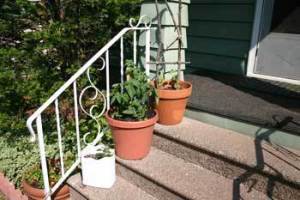 If your ability to garden is limited by a lack of space, a lack of accessibility or poor quality soil, then consider container gardening. All you need is a selection of plants, a few containers, the proper growing medium, and a sunny window, balcony, or porch and you're on your way to an excellent crop of vegetables or flowers.
If your ability to garden is limited by a lack of space, a lack of accessibility or poor quality soil, then consider container gardening. All you need is a selection of plants, a few containers, the proper growing medium, and a sunny window, balcony, or porch and you're on your way to an excellent crop of vegetables or flowers.
The varieties of vegetables, flowers and herbs that thrive well in containers are nearly limitless. Vertical "climbers" like bush beans, peas, cucumbers, and tomatoes adapt to container conditions easily. Vegetables like lettuce, eggplants, onions, carrots, peppers, potatoes, even corn and squash work well, too. In general, small, quick maturing crops perform best, as do compact varieties of normally large plants like cabbage and melons.
The success of container grown plants is highly dependant on the quality of growing medium provided for them. Both air and water are needed to support proper root growth so container soil should be somewhat porous. The soils typically used in gardens tend to be too heavy for container gardening. They compact easily and don't offer good drainage. A packaged lightweight potting mix works well. Some of these are slightly acidic so amendments may be needed.
Containers can be purchased, built or recycled from items found around the house or garage. The most important consideration is choosing containers that best accommodate your plants. Onions and radishes will grow fine in aluminum cake pans. Root plants, like carrots, need a deeper container.
Plastic containers are lighter weight, but can become brittle in cold temperatures. Terra cotta containers are wonderfully porous and beautiful to look at, but are heavy, break easily and tend to dry out more quickly. Wooden containers made from cedar or redwood are more naturally rot-resistant than other woods. Metal containers heat up rapidly which can cause root damage, so consider using a clay or plastic pot as a liner.Other things to consider are color and drainage. Dark colored containers absorb more heat, sometimes too much, which can damage plant roots and make it difficult for them to thrive.
Make sure all your containers have adequate drainage on the bottom or sides near the bottom. Place them on brick feet or place a saucer under them to catch excess drainage or consider setting them on castors (before filling with heavy dirt!) to keep them easy to move.
Watering: Plants growing in containers dry out more quickly and need frequent watering. Because their roots can't dig deeper to find moisture, they need constant attention. Check them daily in warm temperatures and give them water until you see it draining from the bottom of the container. Keep newly sown seeds and transplants moist and water older plants when the top inch of soil becomes dry. Mulch containers with grass or gravel pebbles to reduce moisture loss between watering.
Fertilizing: It's necessary to supplement the growth of container plants with fertilizer due to nutrients leaching out from frequent watering. After the first 3-4 weeks of growth, add a diluted organic fertilizer like seaweed extract, fish emulsion, manure tea, or compost tea when watering. Do this every two weeks and adjust fertilizer levels as necessary according to how the plants respond.
Light: The amount of light your container needs will vary by crop. Most plants require at least 5-6 hours of full sun per day. This can be maximized with the addition of reflective materials (aluminum foil, glass marbles) placed around containers.
ThriftyFun is one of the longest running frugal living communities on the Internet. These are archives of older discussions.
I would like to try container gardening. Does anyone have any hints, tips, ideas? Do's and Don'ts?